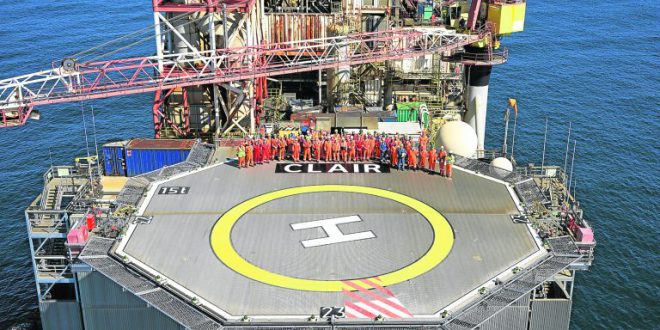Now 40 years later. BP’s using breakthrough 4D seismic technology to continue to unlock its potential.
The technology has captured the attention of BP’s global portfolio with chief executive Bob Dudley singling it out in an industry address. The technology. which will reveal a whole new level of detail and critical data. could also be deployed elsewhere in the oil giant’s portfolio.
“In my role I helped support the justification for a 4D seismic programme on the first development phase on Clair.“ Ms Ball said.
“Clair is extremely challenging. It’s complex structurally. The subsurface really drives the requirement for high-spec data on the field. Back in 2005. we met that requirement with a permanent array that was placed on the seabed.
“I was involved in the feasibility study upfront that said if we’re going to make this work than we really need to go with the most high spec solution available. Thankfully. it was a successful pilot. and if we wind forward 10 years we’ve still got the same requirements for high spec data on Clair. but the technology has moved on. It means the solution now is very different to 10 years ago and we learned a lot of lessons from the phase one experience that has helped define a way forward for Clair Ridge.“
The solution is a ‘world first’ for BP.
“That solution is the most densely sampled seismic survey that BP has acquired in a marine environment.“ she said.
“It’s using ocean bottom nodes. which weigh 30kg. They are about 18 inches in diameter and they contain a hydrophone and geophone. that are used to collect the acoustic energy. which comes back from the subsurface. These were placed on the seafloor at spacing of 100metres by 50 metres. The total number of receiving stations that we had on Clair Ridge was 13.500. We only had 5.500 at any one time. so it was a rolling cache. To give an idea of how that compares with the previous survey. the data sampling was 14 times stronger than last time.
“You can think of that in terms of an image resolution of a photograph on your mobile phone. Obviously. the more pixels you have. the better sample the data is. the better image quality. The uplift relative to the last survey is a similar to uplift of the number of pixels you might have on an iPhone versus the number of pixels you’ll have on a 4G television.
“With that we’re really expecting a dramatic improvement of the image quality of the data.
“The objective of this survey is to acquire what we call a 4D baseline for a programme on Clair Ridge. where we will be re-acquiring seismic data every three to four years. We can think of seismic imaging in a similar way to ultrasound imaging. With ultrasound imaging we are using very high frequency soundwaves to pick up on the contrast and density of the soft tissue. Obviously. that gets reflected back and provides us with an image. It’s exactly the same for seismic data. but we’re using longer frequency soundwaves and picking up on difference in the sub-surface. The idea is if we come back and reacquire the data every three to four years. and the difference of data set is relative to the baseline. we’ll be able to track fluid movements within the reservoir and pressure changes within the reservoir that can inform of us of any bottles or compartments and they can also inform about how the water flood is moving around the reservoir.“
Fairfield helped develop the node technology and BP is working with its partners. Shell. ConocoPhillips and Chevron. throughout the project.
The data acquisition totalled 90 days. The data then undergoes a year-long processing. Final results are expected in August 2018.
“The Clair reservoir is old and that means the core space which the hydrocarbons are moving around is very small compared to other fields. and that reduces the size of the 4D response.“ the North Sea expert said. “With the survey that we’ve acquired this year. there’s a lot of attention on the survey from around the globe in terms of what the dense sampling will deliver for us. “This is by far the greatest step change in data sampling that we’ve had on the field to date. One of the largest challenges for the Clair reservoir is that it’s a highly fractured reservoir. Those fractures have a big impact on production and a big impact on how the injections support reaches the producers.
“4D surveillance is perhaps more critical on Clair than it is on other fields in terms of monitoring those complex flood patterns. And also we’re hoping the dense sampling might unlock the potential for directly mapping the density of those fracture networks on the field as well. which would be a huge help.
“Ultimately. the aim for any 4D programme is to improve the recovery factor on the field and that’s what we’re looking to do with the 4D seismic on Clair.“
She added: “We’re also exploring the use of complementary seismic acquisition. which is using downhole seismic sensor to also provide an additional surveillance tool for our reservoir. The plan is that we’ll acquire this every three to four years. but given we have this highly fractured reservoir and it’s difficult to predict the flood patterns. there would also be benefit if we could annually image those flood patterns. especially for new injectors that are drilled. so we can quickly understand how effective the sweep is from those injectors.“ BP was able to pilot that complementary technology this year. with the results expected in early 2018.
The process. which involved a heavy justification. is hugely rewarding according to Ms Ball.
“It’s a real privilege. especially working on this project.“ she said.
“I was first involved with the justification for this survey back in 2011.
“Programmes do take a fair amount of justification. so for me personally to see that come to fruition this year and looking forward to seeing what the results come back like is really exciting.“
The Clair field was discovered in 1977. but challenging reservoir characteristics and the technological limits of the time meant it was 2001 before BP and partners approved a development plan for a first phase of development.
Phase One was brought on stream in 2005. targeting approximately 300million barrels of recoverable reserves. It was the first fixed offshore facility to be installed in the West of Shetland area.
To the north of Phase One is Clair Ridge. where BP is targeting 640million barrels of recoverable resources. The multibillion-pound investment involves two new bridge-linked platforms. construction of which was completed in 2016.
Hook-up and commissioning is now well under way with first oil expected in 2018.
Clair Ridge is designed to continue producing until 2050.

 Iran Energy News Oil, Gas, Petrochemical and Energy Field Specialized Channel
Iran Energy News Oil, Gas, Petrochemical and Energy Field Specialized Channel



